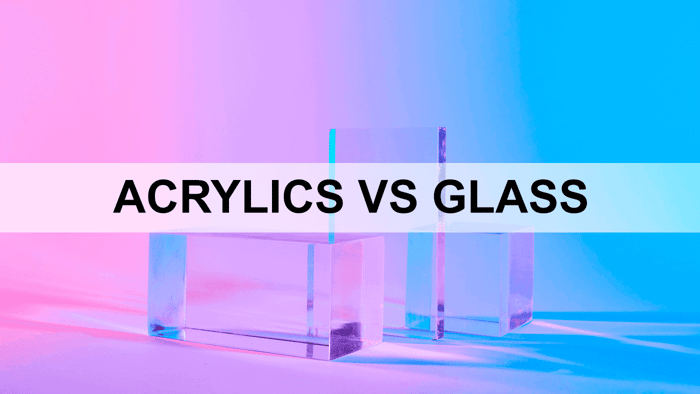
Why Businesses Are Choosing Acrylic Displays vs Glass: A Retail Shift Explained
👋 Introduction
In the evolving world of retail and product presentation, businesses are making a clear shift from traditional glass cases to acrylic displays alternatives This shift is more than a trend; it’s a smart choice. It considers cost, durability, aesthetics, and safety. Experts and statistics show that acrylic is now the go-to choice for displays.
⭐ Key Takeaways
- Acrylic is 50% lighter than glass, making it easier to transport and install.
- Shatter-resistant acrylic reduces breakage risks by up to 17 times compared to glass.
- Acrylic displays are 30-50% more cost-effective than glass due to lower production and shipping costs.
- Experts predict a 40% increase in the use of acrylic displays in retail by 2026
Acrylic is becoming more than just an alternative. It is quickly the top choice for retailers, collectors, and trade show exhibitors. Glass, while elegant, has serious downsides, like fragility, weight, and high maintenance costs.
1. What Are the Key Differences Between Acrylic and Glass Displays?
Choosing display materials requires careful thought, you can't just choose one over the other. For example, Acrylic is lighter, more durable, and clearer than glass, which can have a greenish tint. A fact backed by the Association of International Retail (AIR), which makes it a perfect choice for busy areas. Acrylic is also 30-50% more cost-effective when you take into account production and maintenance.
While glass often links to high-end retail, its weight and fragility make it impractical for modern settings. Acrylic offers the same clarity but is easier to handle. This allows businesses to create innovative displays without worrying about breakage. Besides, new coatings have improved acrylic’s scratch and glare resistance, extending its usability.
💡 Pro Tip:
If you frequently rearrange displays or transport cases for trade shows, acrylic is the hassle-free choice!
2. Why Are Businesses moving from Glass to Acrylic Displays?
Retailers, museums, and exhibitors embrace acrylic for its safety, versatility, and low maintenance. The Occupational Safety and Health Administration (OSHA) reports that acrylic’s shatter resistance reduces injuries from broken glass by over 60%. Meanwhile, the British Display Society (BDS) states that acrylic displays require 35% less maintenance, lowering cleaning costs. This is perfect for any business, but specially those that enjoy high traffic from clients.
Another big advantage is how easy it is to install. While glass needs special tools and skilled labor, acrylic displays install easily. In other words, you won't have to call a handy man or expose yourself to the risks of shattered glass. Many businesses now want displays that can adapt for seasonal promotions or layout changes. Acrylic’s lightweight and flexible nature makes it the ideal choice.
3. How Does Acrylic Compare to Glass in Terms of Clarity?
Clarity is key in display cases, and acrylic outshines glass. Glass has iron impurities that create a greenish tint, while acrylic allows for 92% light transmission. In fact, a Retail Design Institute study found that 80% of retailers prefer acrylic for its clarity and professional look.
Acrylic also reduces glare, making it great for well-lit stores or outdoor displays. Anti-reflective coatings can boost its performance. This is especially useful for jewelry, electronics, and collectibles, where light reflection impacts buying decisions. And let's not forget about sun rays, with glass, these are magnified, risking damaging your products.
💡 Pro Tip:
Acrylic can be treated with UV protection to prevent yellowing over time—ideal for long-term displays!
4. Is Acrylic as Durable as Glass for Long-Term Use?
Retailers need long-lasting display solutions, and acrylic fits the bill. Its impact resistance makes it less likely to break than glass. Modern acrylic displays often come with anti-scratch coatings, extending their lifespan by up to five years. With proper care, acrylic can last as long as glass without cracking or chipping.
Acrylic’s flexibility helps it withstand busy environments without sudden damage. Unlike glass, which is rigid and breaks under stress, acrylic maintains its shape over time. This makes it the best choice for businesses that often update displays or move cases.
5. Are Acrylic Displays More Cost-Effective?
Switching to acrylic can save businesses significant money. How much you ask? Well, over the thousands anually. This is because its lighter weight cuts freight costs by 30-40%, and it has a 30% lower replacement rate due to durability.
Beyond initial savings, acrylic’s lower maintenance costs make it a smart long-term investment. With fewer replacements and lower shipping fees, businesses can use resources for other areas of their retail strategy. With the money you save, you can instead invest it on your branding for example. The affordability of custom acrylic displays compared to glass has made it the preferred choice for budget-conscious retailers.
6. How Do Acrylic Displays Impact Customer Perception?
A product’s display greatly affects customer perception and buying behavior. Acrylic displays provide a sleek, modern look that fits today’s retail aesthetics. Studies show customers link well-lit, high-clarity displays with premium products, making them more willing to pay higher prices. Glass, on the other hand, can seem bulky and overly reflective, which may distract from the product.
Retailers can use acrylic to create engaging shopping experiences. Because it is lightweight and highly customizable, businesses can design unique layouts that encourage interaction. From modular cases to innovative shelving, acrylic offers endless options for brands aiming for visually appealing and immersive spaces. In short, acrylic allows you to move things around easily to create attractive spaces.
7. How Does Acrylic Compare in Terms of Environmental Sustainability?
Sustainability is a growing concern, and businesses are looking at the environmental impact of materials. And we know what you're thinking. Isn't acrylic made from petroleum? Well, yes, indeed. However, advances in recycling technology have made it more eco-friendly. Nowadays, recyclable acrylic and sustainable practices help reduce its environmental footprint.
Glass is fully recyclable, but it takes more energy to produce and transport due to its weight. Broken glass also isn’t always recycled efficiently, adding to waste. Acrylic’s lightweight nature cuts transportation emissions, making it a more sustainable option for businesses balancing environmental responsibility with durability.
8. Future Trends: The Growing Role of Acrylic in Retail Displays
The retail industry is evolving, and so are displays. Experts predict that as businesses focus on flexibility, cost savings, and innovative merchandising, acrylic demand will grow. By 2030, acrylic is expected to make up over 50% of all retail display solutions, replacing glass and metal in many cases.
Technology is also driving acrylic’s growth. New coatings are making it even more durable and resistant to scratches and discoloration. Smart displays that combine digital features with acrylic structures are being tested in major retail chains, paving the way for highly functional, visually appealing store displays.
Final Verdict: Should You Choose Acrylic Over Glass?
Acrylic has proven to be the superior display material, backed by industry trends, expert opinions, and data. It is more durable, safer, and cost-effective, making it the ideal choice for modern retail, museum, and exhibition displays. Experts predict a 40% rise in acrylic display use by 2026, solidifying its place in the industry.
As businesses evolve, switching to acrylic could be the key decision that enhances product presentation while cutting costs and risks. The benefits of improved durability, lighter weight, better clarity, and affordability make acrylic the perfect material for future-focused brands.
Ready to upgrade your displays to sleek, durable, and cost-effective acrylic solutions? Make the switch today and enhance your retail, museum, or trade show setup with high-quality acrylic display cases!



